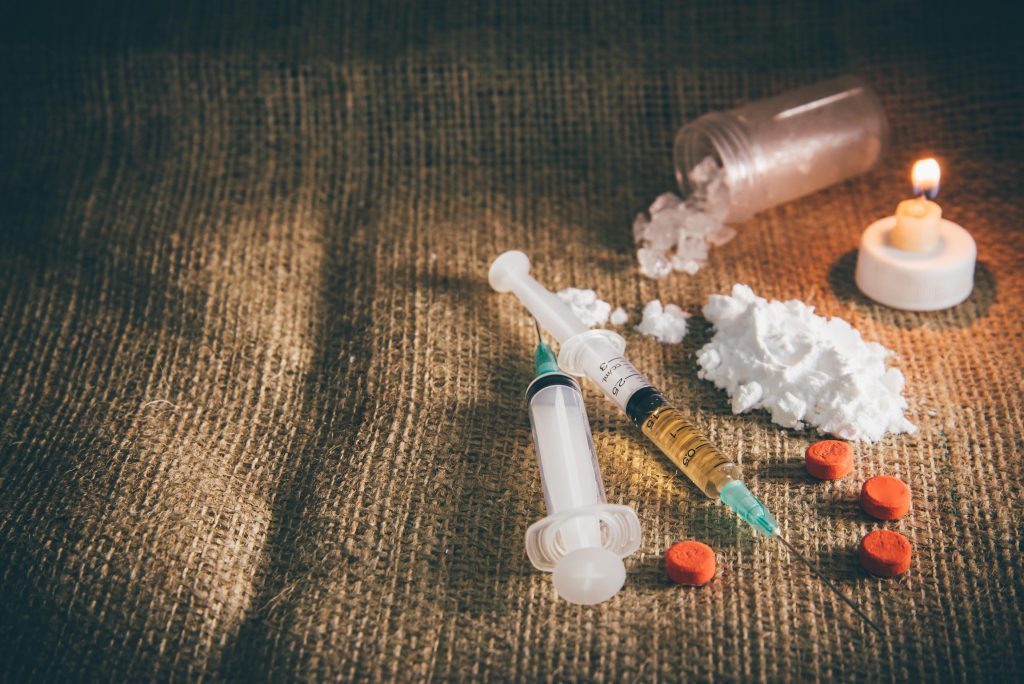HEROIN.
Heroin is a highly addictive, illegal drug. It is used by millions of addicts around the world who are unable to overcome the urge to continue taking this drug every day of their lives-knowing that if they stop, they will face the horror of withdrawal.
Heroin (like opium and morphine) is made from the resin of poppy plants.
Milky, sap-like opium is first removed from the pod of the poppy flower. This opium is refined to make morphine, then further refined into different forms of heroin.
Most heroin is injected, creating additional risks for the user, who faces the danger of AIDS or other infection on top of the pain of addiction.
The origins of Heroin
Heroin was first manufactured in
1898 by the Bayer pharmaceutical company of Germany and marketed as a treatment for tuberculosis as well as a remedy for morphine addiction.
A VICIOUS CIRCLE
During the 1850s, opium addiction was a major problem in the United States.
The “solution” was to provide opium addicts with a less potent and supposedly
“non-addictive” substitute-
morphine. Morphine
addiction soon became a bigger problem than opium addiction.
As with opium, the morphine problem was solved by another “non-addictive” substitute–heroin, which proved to be even more addictive than morphine. With the heroin problem came yet another
“non-addictive” substitute–the drug now known as methadone. First developed in 1937 by German scientists searching for a surgical painkiller, it was exported to the US and given the trade name “Dolophine” in
Renamed methadone, the drug was soon being widely used as a treatment for heroin addiction. Unfortunately, it proved to be even more addictive than heroin.
By the late 1990s, the mortality rate of heroin addicts was estimated to be as high as 20 times greater than the rest of the population.
What does Heroin look like ?
In its purest form, heroin is a fine white powder.
But more often, it is found to be rose, gray, brown or black in color.
The coloring comes from additives which have been used to dilute it, which can include sugar, caffeine or other substances.
Street heroin is sometimes “cut” with strychnine or other poisons.
The various additives do not fully dissolve, and when they are injected into the body, can clog the blood vessels that lead to the lungs, kidneys or brain.
This itself can lead to infection or destruction of vital organs.
The user buying heroin on the street never knows the actual strength of the drug in that particular packet. Those users are constantly at risk of an overdose.
Heroin can be injected, smoked or sniffed.
The first time it is used, the drug creates a sensation of being high. A person can feel extroverted, able to communicate easily with others and may experience a sensation of heightened sexual performance-but not for long.
Heroin is highly addictive and withdrawal extremely painful. The drug quickly breaks down the immune system, finally leaving one sickly, extremely thin and bony, and, ultimately, dead.
The destructive effects of Heroin

IMMEDIATE HARM
“rush.” This is often accompanied by a warm feeling of the skin and a dry mouth.
Sometimes, the initial reaction can include vomiting or severe itching.
After these initial effects fade, the user becomes drowsy for several hours. The basic body functions such as breathing and heartbeat slow down.
Within hours after the drug effects have decreased, the addict’s body begins to crave more. If he does not get another fix, he will begin to experience withdrawal. Withdrawal includes the extreme physical and mental symptoms which are experienced if the body is not supplied again with the next dose of heroin. Withdrawal symptoms include restlessness, aches and pains in the bones diarrhea, vomiting and severe discomfort
The intense high a user seeks lasts only a few minutes. With continued use, he neer increasing amounts of the drug just to fet
“normal.”

SHORT-TERM EFFECTS
“Rush”
Slowed breathing
Clouded mental functioning
Nausea and vomiting
Sedation; drowsiness
Hypothermia
(body temperature lower than normal’
Coma or death (due to overdose)

LONG TERM EFFECTS
The effects on the body from continued use of this drug are very destructive. Frequent injections can cause collapsed veins and can lead to infections of the blood vessels and heart valves.
Tuberculosis* can result from the general
poor condition of the body.
Arthritis is another long-term result of heroin addiction.
The addict lifestyle–where heroin users often share their needles -leads to
AIDS and other contagious infections.
Long-Term effects
• Bad teeth
• Inflammation of the gums
• Constipation
• Cold sweats
• Itching
• Weakening of the immune system
• Coma
• Respiratory (breathing)
illnesses
• Muscular weakness, partial paralysis
• Reduced sexual capacity and long-term impotence in men.
• Menstrual disturbance in women
• Inability to achieve orgasm (women and men)
• Loss of memory and intellectual performance
• Introversion
• Depression
• Pustules on the face
• Loss of appetite
• Insomnia
